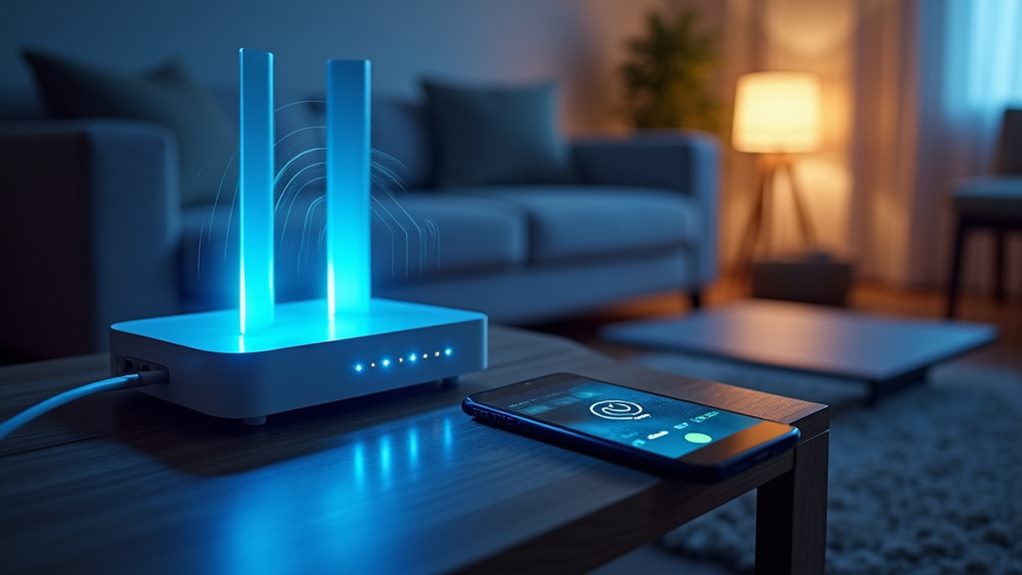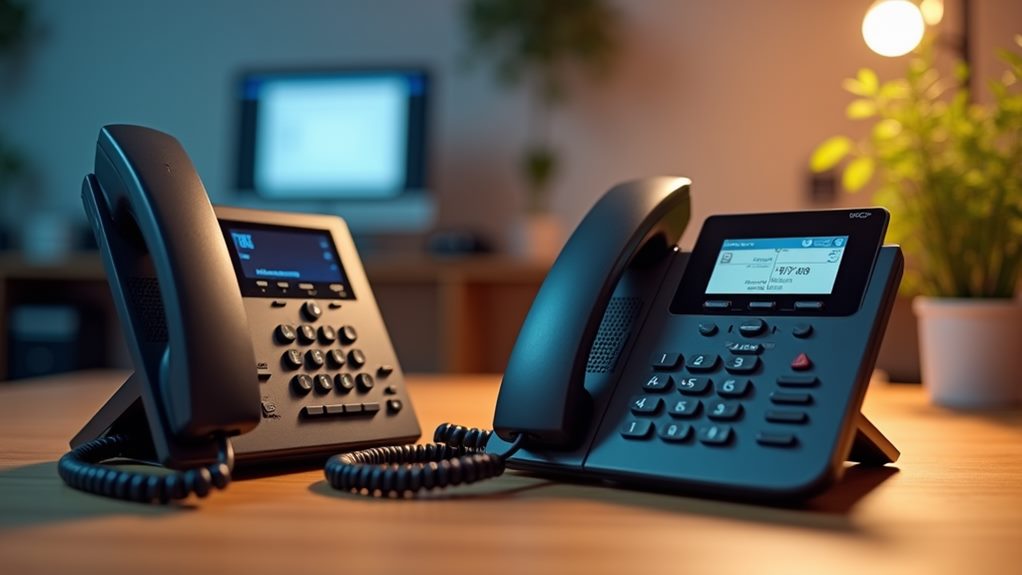Sky offers a full VoIP service integrated with their broadband infrastructure, letting you make calls through your internet connection rather than traditional copper phone lines. You'll need to connect your compatible phone to the Sky Hub's ATA port to access the service. Most standard landline phones work seamlessly, though BT Digital Voice handsets aren't compatible with Sky's system. The service operates through your Sky Hub, providing reliable voice calls as part of Sky's shift away from traditional PSTN networks ahead of the 2025 switchover. Exploring Sky's VoIP specifications will help you understand your setup options and compatibility requirements.
Understanding Sky's VoIP Service

Sky's VoIP service integrates seamlessly with their broadband infrastructure, allowing customers to make voice calls through their internet connection. The system operates through your Sky Hub, transforming your internet connection into a reliable phone service that maintains the familiar experience of using a standard landline phone.
By utilizing advanced VoIP technology, this service guarantees clear calls and flexibility, similar to the capabilities offered by Xfinity VoIP services for enhancing communication.
When you're using Sky's VoIP service, you'll find that most traditional phones are compatible with the system. You simply connect your existing phone to the Sky Hub, and you're ready to make calls over the internet rather than through the old PSTN network.
This integration represents part of the nationwide shift away from traditional copper phone lines, which will be phased out by 2025.
As a Sky broadband user, you'll benefit from the built-in VoIP capabilities of your Sky Hub, eliminating the need for additional VoIP-specific hardware.
However, if you're switching from another provider like BT, you'll need to verify your current phone's compatibility. While most standard phones work well with Sky's VoIP service, certain BT Digital Voice handsets may not function correctly with the Sky system, requiring potential equipment updates.
Phone Compatibility Requirements
When moving to VoIP service through Sky, your phone's compatibility plays an essential role in guaranteeing seamless communication.
Sky broadband's VoIP service supports most standard phone models through the ATA port on your Sky hub, making the shift straightforward for many users. Before making the switch, it's important to take into account your financial implications for effective budgeting, as this will help you choose the right equipment that fits within your budget.
You'll find that standard landline phones, including both corded phones and DECT phones, work effectively with Sky's system without requiring special VoIP settings.
However, if you're switching from BT, you should note that BT Digital Voice handsets won't work with your Sky hub, as they're specifically designed for BT's Smart Hub 2.
To guarantee proper functionality, you'll want to perform compatibility checks before committing to the service.
Start troubleshooting by connecting a basic corded phone to test the line. If you're planning to purchase new equipment, focus on phones designed for universal compatibility rather than provider-specific models.
This approach will help you avoid potential connectivity issues and guarantee your VoIP service works as intended.
Remember that selecting the right equipment is vital for maintaining reliable communication through your Sky hub's landline phone connection.
Setting Up Your Connection

Once you've confirmed your phone's compatibility, the technical setup process follows a precise sequence of steps to establish your VoIP connection through the Sky Hub.
Begin by connecting your compatible phone directly to the Sky Hub's ATA port, which enables seamless integration with Sky's VoIP infrastructure without requiring complex configuration settings. Ensuring a minimum level of VoIP account setup is also essential for smooth functionality.
Your broadband service forms the foundation of your VoIP functionality, so you'll need to verify its stability before proceeding. Initiate a restart of your Sky Hub to synchronize all connections, and watch for the Voice service light to illuminate, confirming proper system initialization. This indicator serves as your visual confirmation that the VoIP service is ready for use.
If you experience connectivity issues, implement a systematic troubleshooting approach. Test your phone through a traditional wall socket to isolate potential hardware problems.
You're not alone in this process – Sky's community forums offer valuable peer insights for common setup challenges. For specialized assistance, Sky's customer support team stands ready to guide you through any technical hurdles.
Common Technical Issues
Recognizing technical issues early can prevent disruption to your VoIP service. One common indicator of setup problems is when your Sky Hub doesn't display a Voice light, suggesting connectivity issues with the VoIP functionality. If you're experiencing this, you'll need to verify your Sky Broadband connection is stable and properly configured.
You might encounter compatibility challenges when attempting to use BT Digital Voice handsets with your Sky VoIP system. These devices aren't designed to work with Sky's network infrastructure, which can lead to connection failures. If you're using a cordless phone that previously worked with BT, you'll likely need to replace it with a Sky-compatible model.
When troubleshooting phone functionality, start by connecting your handset directly to the wall socket to isolate the problem. If the issue persists, check that your Sky Hub is operating correctly and all cables are securely connected.
For unresolved technical issues, you'll need to contact Sky's technical support team. They can access advanced diagnostics and provide specific guidance for your setup, ensuring your VoIP service functions as intended.
Switching From Traditional Landlines

As the UK approaches the nationwide PSTN switch-off in December 2025, Sky customers must prepare for the changeover from traditional copper-wire landlines to VoIP technology.
When you're switching to Sky's broadband service, you'll likely convert to their VoIP system immediately, which means your existing phone setup may need modifications.
If you're currently using Sky Talk Line Rental, you'll maintain service until the switchover, but you should be proactive about staying informed since conversion updates aren't always promptly communicated.
The phone network evolution requires particular attention if you're moving from BT to Sky, as BT Digital Voice handsets typically won't integrate with Sky's VoIP infrastructure.
Before making the switch, you'll need to assess your existing equipment's compatibility with Sky's VoIP platform.
Your traditional landline phones may require adapters to function with the new system, and some models mightn't work at all.
It's essential to verify compatibility before the conversion to avoid service interruptions.
Sky's move to VoIP aligns with the broader industry shift, ensuring you're part of the modern telecommunications framework while maintaining essential voice communications.
Final Thoughts
Sky's VoIP service integration into your home network requires careful consideration of your existing infrastructure, much like upgrading from a telegraph to telephone in the 1900s. You'll need a minimum 10Mbps downstream connection and Sky's compatible router to guarantee peak QoS performance. When moving from PSTN to VoIP, you'll maintain your existing number while gaining advanced features like HD voice codecs and multi-device integration through SIP protocol support.

